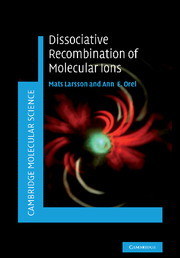2 - Experimental methods
Published online by Cambridge University Press: 03 May 2010
Summary
Several experimental methods were mentioned in Chapter 1. In this chapter most of these methods will be described in more detail. They represent the experimental methods that have produced the vast majority of the dissociative recombination data.
Merged beams
Kinematics and resolution
It follows from Chapter 1 that the cross section for dissociative recombination is inversely proportional to the kinetic energy of the incident electron, and that resonances in the cross section may occur because of interferences between the indirect and the direct process. For these reasons, the ideal method for detailed studies of the cross section is the merging of beams of electrons and beams of molecular ions. The application of merged beams to the study of atomic and molecular collision processes has been comprehensively reviewed by Phaneuf et al. (1999).
A perfect experiment by means of merged beams would consist of a monoenergetic beam of ions interacting, at an angle of 0°, with a monoenergetic beam of electrons over a precisely known distance, and with no other atoms or molecules present. The beams overlap perfectly, and the velocity and currents of the beams are precisely known. The neutral reaction products are detected with 100% efficiency. This ideal situation can never be realized, of course. A beam of charged particles has an energy spread, it is difficult to keep the angle of intersection at exactly 0°, and no matter how good the vacuum, there will be residual gas molecules present in the interaction region.
- Type
- Chapter
- Information
- Dissociative Recombination of Molecular Ions , pp. 11 - 69Publisher: Cambridge University PressPrint publication year: 2008



